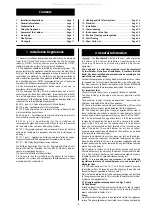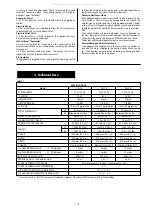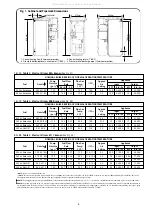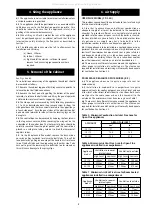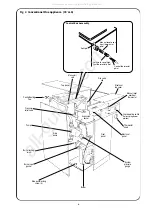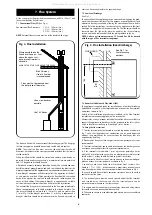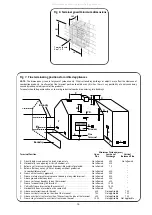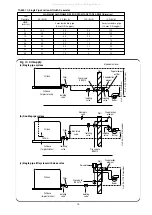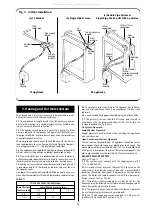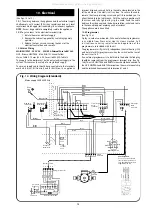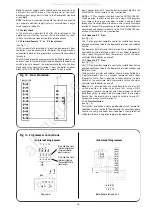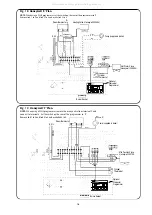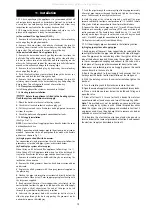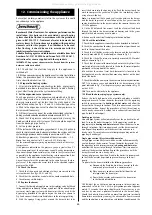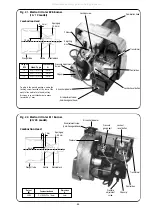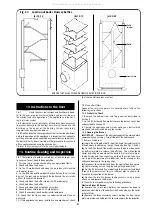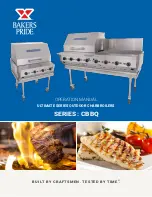
A flue system must be provided in accordance with BS5410:Part 1 and
the current Building Regulations.
7.1 Conventional Flue (CF)
(See Fig. 4).
Conventional Flue Diameters:
12/14 – 100 mm (4 in.)
15/19 – 100 mm (4 in.)
20/25 – 100 mm (4 in.)
NOTE:
External flues systems must be of the insulated flue type.
The boiler is fitted with a conventional flue locating spigot. The flue pipe
fits into the spigot and should be correctly sealed with fire cement.
NOTE:
The size of the flue must never be reduced from the take-off
diameter. An increase in flue size is permissible provided that the joint is
sealed correctly.
When installed the flue should be vertical and contain as few bends as
possible. Where bends are necessary, a maximum of two are permitted
and 135 degree bends should be used.
All brick and masonry chimneys should be lined with a suitable non-com-
bustible material, properly jointed and able to withstand the effects of the
working temperature of the appliance and any condensate which may form.
Down-draught conditions will adversely affect the operation of the boil-
er and must be avoided. Where possible the flue should be extended
beyond the apex of the roof and should always be taken beyond the
eaves of the building. Where down-draught is experienced a suitable
anti down-draught terminal should be fitted to the flue termination.
The natural flue draught must be checked in the flue pipe immediately
above the appliance or in the hole provided in the flue outlet plate. The
flue draught should be no less than 0.75 mm W.g. and no greater than
5.1 mm W.g. If a flue draught greater than 5.1 mm W.g. is experienced a
draught stabiliser should be introduced into the flue and adjusted to
achieve a flue draught within the specified range.
7.2 Low Level Discharge
(See Fig. 5).
The conventional flue appliance may be converted to discharge the prod-
ucts of combustion at low level. For this purpose a special flueless kit and
associated ducting is available, allowing the conventional flue to be dis-
carded. Detailed instructions for converting the appliance to low level
discharge are supplied with the conversion kit. The flue spigot should be
removed from the flue outlet plate, by undoing the three retaining
screws, and the hole blanked off with the plate provided in the kit.
NOTE: Under no circumstances may 35 Second Gas Oil be burned
with this type of flue terminal arrangement.
7.3 Room Sealed Balanced Flue Model (RS).
The appliance is supplied ready for installation as a low level discharge
balanced flue system by the simple addition of one of the flue terminal
kit options shown in Fig. 6.
Details of the installation procedure are included in the Flue Terminal
Installation instructions supplied with the terminal kit.
Alternatively, a range of room sealed balanced flue kits are available to
convert the appliance to discharge the flue products to the left, right, at
a higher level, or vertically up to a roof height of 4.5 metres.
7.4 Siting the flue terminal
1.
The flue terminal must be located in a suitable position, as shown in
Fig. 7, such that the products of combustion can be freely dispersed
without the possibility of the gases entering the dwelling or that of a
neighbouring dwelling.
2.
Discharge of flue gases into car ports or narrow passageways is not
recommended.
3.
The terminal must not cause an obstruction nor the discharge cause
a nuisance as a result of either flue gases or terminal noise.
4.
If the terminal is fitted within 1 m of a plastic or painted gutter or
within 500 mm of painted eaves then an aluminium or stainless steel
shield at least 1 m long should be fitted to protect the surface.
5.
If a terminal is fitted less than 2 metres above a surface to which peo-
ple have access, fit a terminal guard as shown in Fig. 8.
A suitable guard is available from Worcester Heat Systems, Part
Number 7 716 190 009, or alternatively a proprietary terminal guard
may be used provided it has the minimum dimensions shown in Fig. 8.
The guard should have suitable corrosion resistance due to the acidic
content of the flue gases.
6.
The terminal guard must be evenly spaced about the flue terminal
and secured using the screws so that the terminal guard can be
removed for maintenance to the flue terminal.
7.
In certain weather conditions a terminal may steam and siting where
this could cause a nuisance should be avoided.
8.
Take care to ensure that combustion products do not enter ventilated
roof voids.
7. Flue System
8
Fig. 5. Flue Installation (Rear Discharge).
See Fig. 7 for
flue terminating
positions.
80
min.
FLUE GUARD
766
Fig. 4. Flue Installation.
Where possible take the
flue above the apex – if not
above the apex an anti
down-draught terminal is
advisable.
Brick Chimney.
Use of a flue liner
is recommended.
Use as few bends as
possible.
Use 135° Bends.
Flues must not be reduced from
the boiler take off diameter.
ALWAYS TAKE THE FLUE ABOVE THE EAVES
All manuals and user guides at all-guides.com


